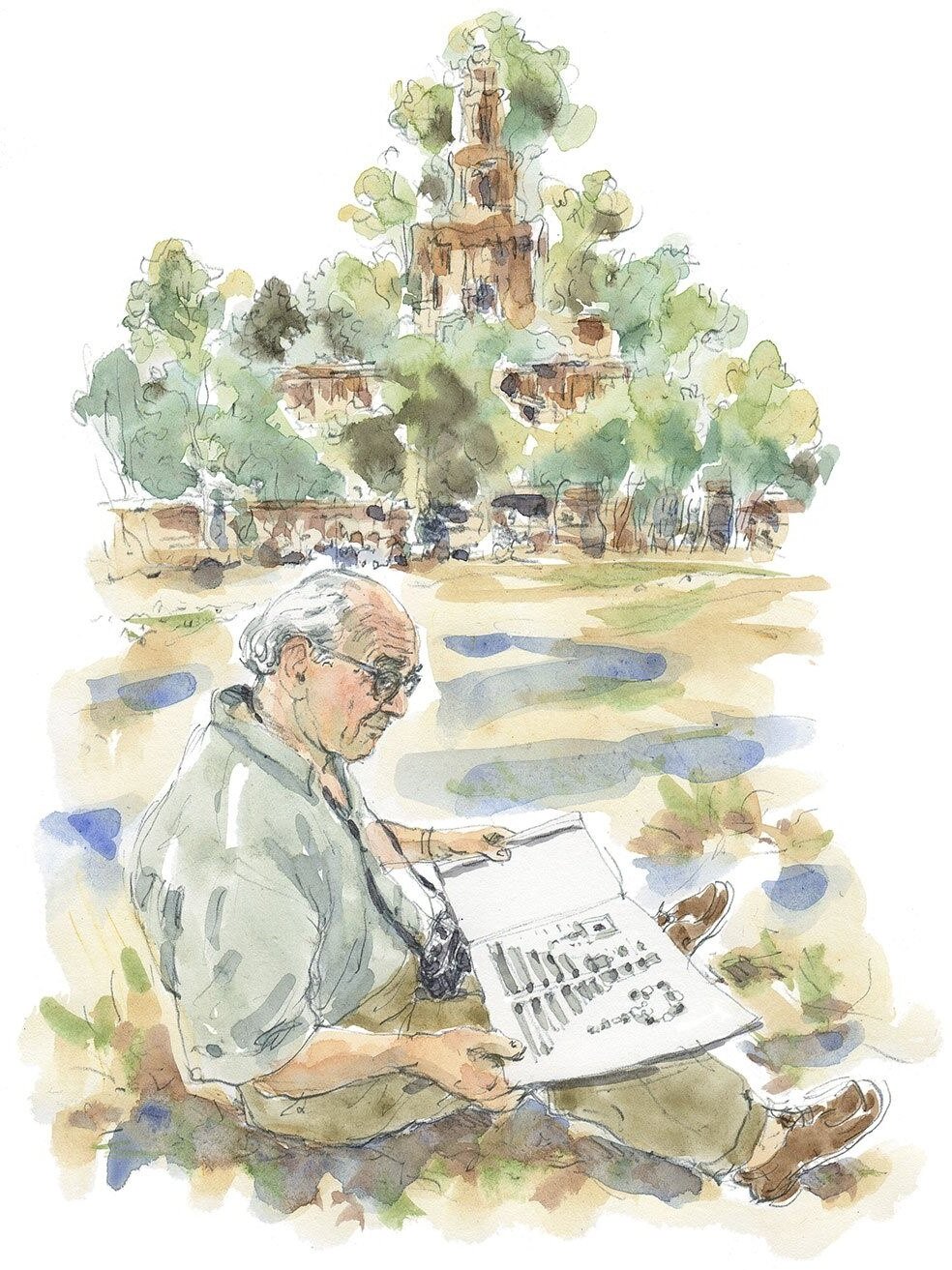Banteay Chhmar
by Peter D. Sharrock & Claude Jacques & Swati Chemburkar & John Sanday & Paisarn Piemmettawat
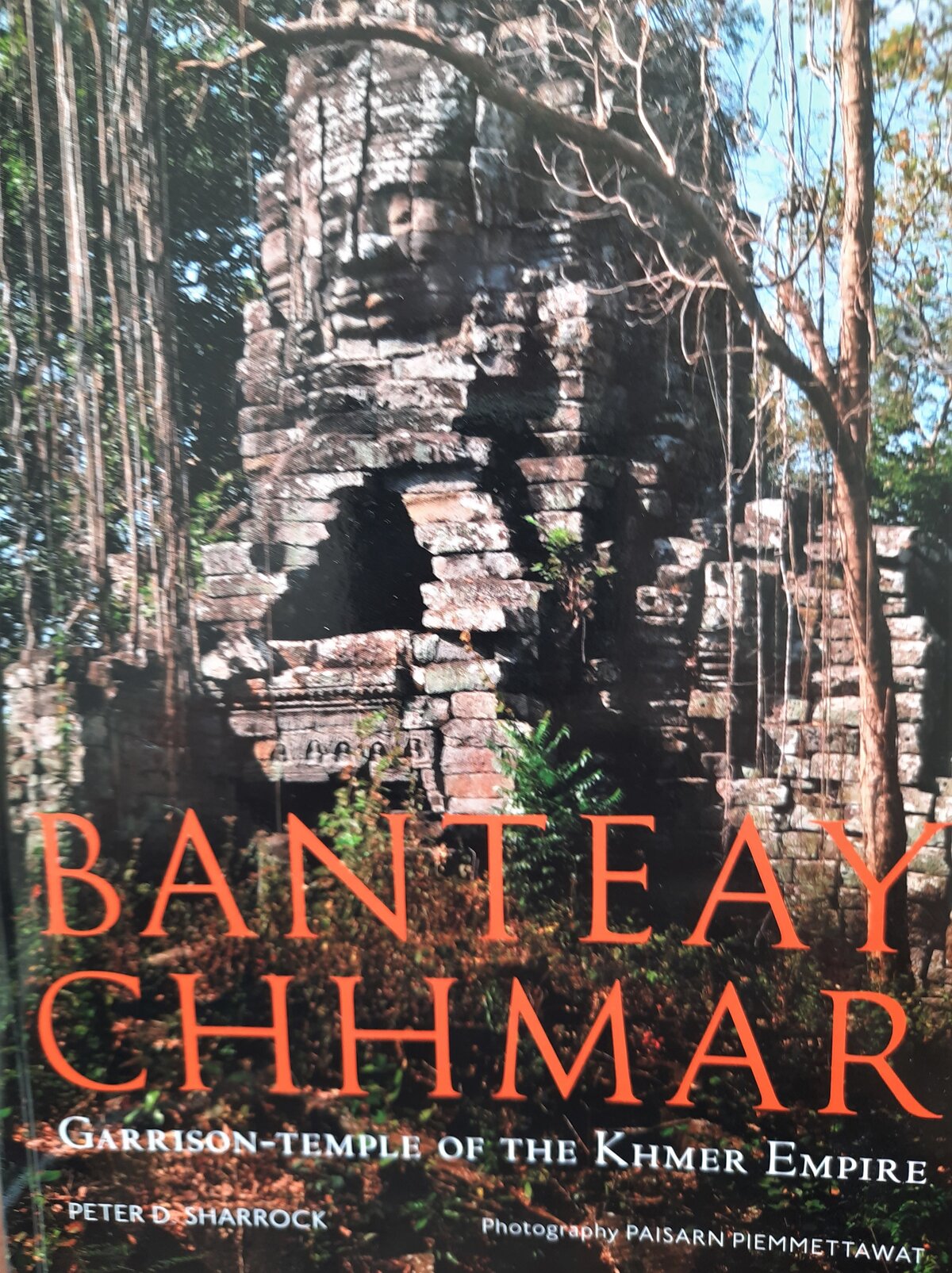
Type: paperback
Publisher: River Books (with Global Heritage Fund)
Published: 2015
Authors: Peter D. Sharrock, Claude Jacques, Swati Chemburkar, John Sanday & Paisarn Piemmettawat
Pages: 200
ISBN: 9786167339207
Language : English
About the Authors
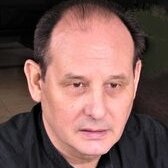
Peter D. Sharrock
A Reuters newsreel agency correspondent during the American war waged in Indochina during the 1960s-1970s, Peter D. Sharrock, PhD, teaches at SOAS/University of London.
He has been studying the spread of Buddhism (and Tantric Buddhism) across Maritime Asia as it is visible in the art and architecture of Cambodia, Vietnam and Java from 800 to 1400 CE.
Peter Sharrock’s writings include Vibrancy in Stone: Masterpieces of the Da Nang Museum of Cham Sculpture (2018), Banteay Chhmar: Garrison-temple of the Khmer Empire (2015) and (with Vu Hong Lien) Descending Dragon, Rising Tiger: a History of Vietnam (2014).
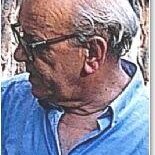
Claude Jacques
Claude Jacques (1929, Marboz, France ‑2018) was a French epigraphist, archaeologist and researcher, the head of EPHE (IVe section) and special advisor to UNESCO for Angkor. For his effort toward the recognition of Angkor monuments as part of UNESCO World Cultural Heritage, King Norodom Sihamoni awarded him the Grand Cross of the Royal Order of Sahametri in June 2017.
After studying under the direction of Pierre Dupont, Louis Dumont, Paul Mus and Louis Renou, he was sent by Jean Filliozat to the Institut français de Pondichéry (India), where he stayed from 1959 to 1961. He met there Bernard-Philippe Groslier, who suggested him to focus on the study of Cambodian inscriptions, continuing George Cœdès’ epigraphic work.
Arrived in Phnom Penh in September 1961 as visiting professor at the Royal University, he helped establishing the Faculty of Archaeology, where he taught until 1970. He joined EFEO in 1963, a member until 1973. He gave numerous conferences in Phnom Penh and Paris for École pratique des hautes études (section des sciences historiques et philologiques), of which he was elected Director in 1973.
Jacques’ profound knowledge of pre- and Angkorean inscriptions led him to call for a reconsideration of the ancient history of Cambodia, an epistemologic departure from previous researches leaning excessively on Chinese sources. His 1979 paper “”Fu-nan’, ‘Zhen-la’: the reality concealed by these Chinese views of Indochina” led the way to a new trend in Cambodian history research.
Co-founder of Association des Amis d’Angkor in 1988, of which he served as general-secretary from 1988 to 1993, he joined Federico Mayor Zaragoza, director of UNESCO, as special advisor on Angkor and Cambodia.
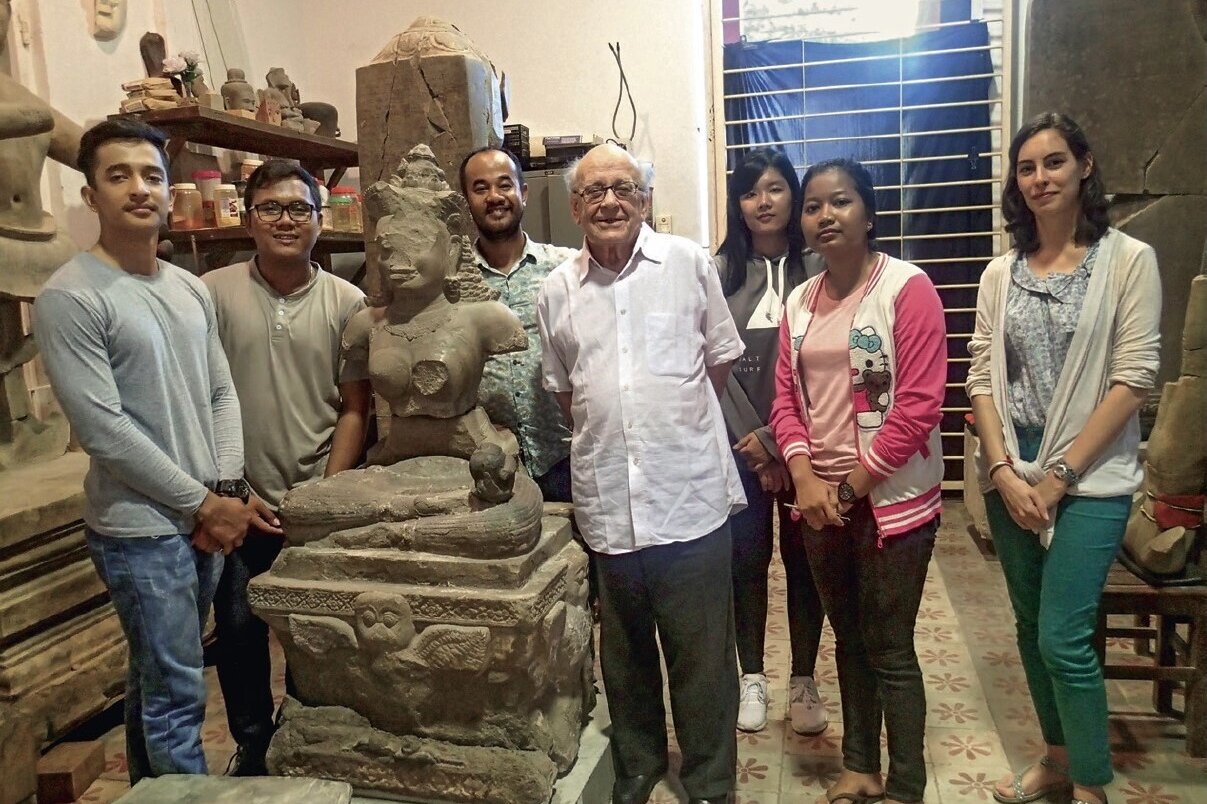
Publications
(from Claude Jacques’s bibliography by Dominic Goodall, BEFEO 106, 2020)
- Gayâmâhâtmya, édition critique, traduction française et introduction, Pondichéry, Institut français d’Indologie (PIFI, 20), 1962.
- Études d’épigraphie cambodgienne [EEC, 11 études] », BEFEO 54, p. 605 – 622 ; 56, p. 57 – 69 et 70 – 73 ; 57, p. 57 – 67, 68 – 89 ; 58, p. 163 – 176 ; 59, p. 193 – 205, 205 – 220 ; 63, p. 351 – 365 ; 65, p. 281 – 332 ; 86, p. 357 – 374, 1968 – 1999.
- [review] “Recueil des inscriptions du Siam 3 publié en thaï sous la direction de Prahya Srivisanvacha en 1965”, BEFEO, 57, 1970, p. 230 – 236.
- “Supplément au tome VIII des Inscriptions du Cambodge, BEFEO 58, 1971, p. 177 – 195.
- “Conférences de M. Claude Jacques, élève diplômé de la Section”, École pratique des hautes études (EPHE), IVe section, Sciences historiques et philologiques, Annuaire 1970 – 1971, 1971, p. 691 – 695.
- “Épigraphie de l’Inde et du Sud-Est asiatique”, EPHE IVe section Sciences historiques et philologiques, Annuaire 1971 – 1972, p. 607 – 610; Annuaire 1972 – 1973, p. 623 – 633; Annuaire 1973 – 1974, p. 703 – 707;
Annuaire 1974 – 1975, p. 909 – 916; Annuaire 1975 – 1976, p. 945 – 953; Annuaire 1976 – 1977, p. 981 – 991; Annuaire
1977 – 1978, p. 1067 – 1080. [1972 – 1978] - “A propos de l’esclavage dans l’ancien Cambodge”, XXXIX Congrès International des Orientalistes, Paris, Asiatheque, 1973, pp. 71 – 76.
- [review] “B.P. Groslier, 1973, Inscriptions du Bayon”, Artibus Asiae 38, 1976, p. 250 – 254.
- [entries] “Bhavavarman Ier”, “Bhavapura”, “Jayavarman I”, “Jayavarman VII”, Encyclopaedia Universalis, 20, (Thésaurus), Paris, 1976.
- “ ‘Fu-nan’, ‘Zhen-la’: the reality concealed by these Chinese views of Indochina”, in Early South-East Asia: Essays in Archaeology, History and Historical Geography, R. B. Smith & W. Watson eds., London, 1979, p. 371 – 379.
- “Nouvelles orientations pour l’étude de l’histoire du pays khmer”, Asie du Sud-Est et Monde Insulindien (ASEMI) 13, 1982, p. 39 – 57.
- “Note additionnelle (à l’édition de K. 1006 par M. Vickery)”, BEFEO 71, 1982, p. 84 – 86.
- [review] “M. Vickery 1979, Cambodia after Angkor, the chronicular evidence for the fourteenth to the sixteenth centuries”, BEFEO 73, 1984, p. 359 – 366.
- “The Kamrateng Jagat in ancient Cambodia”, in Indus Valley to Mekong Delta: Explorations in Epigraphy, Noboru Karashima ed., Madras, 1985, p. 269 – 286. [French: “Les Kamrateng jagat dans l’ancien Cambodge”, in Recherches nouvelles sur le Cambodge, F. Bizot, dir., Paris, EFEO (Études thématiques, 1), 1994.]
- “Le pays khmer avant Angkor”, Journal des Savants, Jan.-Sept. 1986, p. 59 – 95.
- [review] “Ph. Jenner, 1981, A Chrestomathy of Pre-Angkorian Khmer: 2. Lexicon of the Dated, 4 Undated Inscriptions], BEFEO 75, 1986, p. 315 – 318.
- “Sources on Economic Activities in Khmer and Cham Lands”, in Southeast Asia in the 9th to 14th Centuries, David G. Marr & A. C. Millner eds, Singapore, Research School of Pacific Studies/Australian National University/Institute of Southeast Asian Studies, 1986, p. 327 – 334.
- “Cours Année 1985 – 1986”, Paris, École pratique des hautes études, IVe section, typescript.
- “Nouvelles données historiques sur le pays khmer avant Angkor”, The Journal of Sophia Asian Studies 5, 1987, p. 71 – 85.
- “Indochine”, in Jean Tulard (dir.), Dictionnaire Napoléon, Paris, Fayard, 1988, p. 914 – 916.
- “L’empire angkorien : mythe ou réalité ?”, in Cultural heritage in Asia, Manual 2, Tokyo, Institute of Asian Cultures, Sophia University, 1988 [also in Nichi-futsu Bunka (Bulletin de la Maison franco-japonaise de Tokyo), 50, p. 63 – 82].
- “Trois grandes figures de l’archéologie du Cambodge », Dossiers histoire et archéologie 125, 1988, p. 12 – 13.
- “L’épigraphie khmère et les problèmes de l’histoire”, Dossiers histoire et archéologie 125, 1988, p. 14 – 21.
- “Le pays khmer avant Angkor”, Dossiers histoire et archéologie 125, 1988, p. 28 – 33.
- “Six siècles d’histoire angkorienne”, Dossiers histoire et archéologie 125, 1988, p. 38 – 47.
- “Le roi khmer”, Dossiers histoire et archéologie 125, 1988, p. 66 – 71.
- “Les images Spot : Une révolution dans la photo aérienne”, Archéologia 237, p. 26 – 37.
- [with J.-P. Le Gorgeu, J. Stargardt & M. Terrasse], L’apport du satellite Spot à l’archéologie du paysage, Compte-rendu de la table ronde du 27 octobre 1987, Paris, École pratique des hautes études, IVe section,1988, 64 p.
- Corpus des inscriptions du pays khmer, t. I : Inscriptions préangkoriennes nommant un roi, New Delhi, International Academy of Indian Culture, [s.d.] (Sata-Pitaka Series. Indo-Asian Literatures, 34 / Publications hors série de l’École francaise d’Extrême-Orient avec la participation de l’École pratique des hautes études, IVe Section, Sciences historiques et philologiques), 1989.
- “The Khmers in Thailand: What the inscriptions inform us” [trans. by Prof. Subhadradis Diskul of “Les Khmers en Thaïlande : ce que disent les inscriptions »], SPAFA Digest 10, 1989, p. 16 – 24.
- “Angkor : état actuel et perspectives”, Comptes rendus de l’Académie des Inscriptions et Belles-Lettres, 133 (2), 1989, p. 465 – 471.
- “New Data on the VII-VIIIth Centuries History in Khmer Lands”, Southeast Asian Archaeology 1986. Proceedings of the First Conference of the European Association of Southeast Asian Archaeologists in Western
Europe, September 8 – 10, 1986, London, Institute of Archaeology, University College London, 1990, p. 251 – 259. - [Rene Dumont, Jacqueline and Guy Nafilyan), Angkor, Paris, Bordas, 1990.
- “La France et la Conservation des monuments d’Angkor”, Métal pensant, no 1991/A, 1991, p. 108 – 117.
- “Les repères de l’empire de Jayavarman VII en Thaïlande”, Récentes recherches en archéologie en Thaïlande. Bangkok, 2e symposium franco-thaï, 9 – 11 décembre 1991, Bangkok, Silpakorn University, 1991, p. 36 – 41.
- ‘Notice sur George Coedès’, International Dictionary of Archeologists, New York, Garland Publishing, 1991.
- “The use of Sanskrit in the Khmer and Cham inscriptions”, in Middle Indo-Aryan and Jaina Studies / Sanskrit Outside India (2 vols.), Panels of the VIIth World Sanskrit Conference, Volume 6 and 7, Leyde, Brill, t. 2, p. 5 – 12.
- “Sauver Angkor et les temples du Cambodge”, Archéologia 265, 1992, p. 42 – 51.
- [preface to] Georges Coedès, Travaux sur le pays khmer, Paris, EFEO (réimpr.), 1992, 2 vols.
- “Angkor, La splendeur des Khmers”, Sciences et Avenir special edition, 1992, p. 8 – 15.
- “North-East Thailand in History”, in Study on Historic Cities in Lower Northeastern Thailand A.D. 8th-13th Centuries, Cultural Heritage in Asia, no 7, Bangkok, Archaeology Division, Fine Arts Department,
Ministry of Education/Tokyo, Institute of Asian Cultures, Sophia University, 1992, p. 267 – 270. - “On Jayavarman II, the founder of the Khmer Empire”, in Southeast Asian Archaeology 1990. Proceedings of the Third Conference of the European Association of Southeast Asian Archaeologists, Ian Glover ed., Hull, Centre for South-East Asian Studies, 1992, p. 1 – 5.
- “Cahier des charges pour Angkor”, Connaissance des Arts 481, 1992, p. 36 – 43.
- “Espoirs pour Angkor”, Connaissance des Arts 491, 1993, p. 98 – 102.
- Zoning and Environmental Management Plan for the Angkor Area. Angkor and the Khmer History, Paris, UNESCO, typed report, 1993, 42 p.
- Mahendravarman’s campaigns in North-East Thailand: new evidence from the inscriptions of Vat Phu, Symposium on Thai Studies, London, typed document, 1993.
- [with Juan Pablo Fabres), Angkor, Cambodge [CD-ROM], Paris, Centre UNESCO du patrimoine mondial, 1993.
- Magie d’Angkor, Patrimoine 2001, Paris, UNESCO, 1994, 36 p.
- “La date des monuments khmers”, in Comptes rendus de l’Académie des Inscriptions et Belles-Lettres, 136 (4), 1994, p. 883 – 890.
- “China and Ancient Khmer History”, in South East Asia & China : art, interaction & commerce, Colloquies on Art and Archaeology in Asia, no. 17 (6 – 18 June 1994), London/Singapore, Percival David Foundation of Chinese Art, SOAS, University of London/Sun Tree Publishing, 1995: 32 – 41.
- “Khmer History : 1. About modifications in some Angkor temples and their signification in Khmer history, Renaissance Culturelle du Cambodge 11, Tokyo, Institute of Asian Cultures, Sophia University, 1995, p. 187 – 201.
- [with Ishizawa Yoshiaki] “Khmer History : 2. The Sophia University Angkor International Survey Mission since 1980”, Renaissance Culturelle du Cambodge 11, Institute of Asian Cultures, Sophia University, 1995, p. 202 – 206.
- “Les Khmers en Thaïlande : Ce que nous disent les inscriptions”, in La Thaïlande des débuts de son histoire jusqu’au XVe siècle, Bangkok, Silpakorn University, 1995, p. 38 – 44.
- “L’eau et l’épigraphie”, in Colloque International Angkor et l’Eau, 27 – 28 juin, Siem Reap (Cambodia), 1995, typed document, 12 p.
- [editor] Études épigraphiques sur le pays cham de Louis Finot, Édouard Huber, George Coedès et Paul Mus, Paris, EFEO, 1995. [reprint]
- “Les rois khmers : Harṣavarman II et Rājendravarman”, in Studies and Reflexions on Asian Art History and Archaeology. Essays in honour of H.S.H. Professor Subhadradis Diskul, Bangkok, Silpakorn University, 1995, p. 485 – 490.
- “Funan, Zhenla, Srîvijaya”, in Les apports de l’archéologie à la connaissance des anciens États en Thaïlande, 3e Symposium franco-thaï, 11 – 13 Dec. 1995, Bangkok, Université Silpakorn, 1995, p. 14 – 23.
- “Angkor”, in Actes du colloque international des villes du patrimoine mondial, no 1, 1996, p. 4 – 15.
- “Des inscriptions khmères en vente chez les antiquaires de Bangkok”, Paris, 1996, typed document, 3 p.
1997. - [with Suzanne Held, photographer] Angkor : vision de palais divins, Paris, Hermé, 1997.
- “Chronologie du pays khmer”, Dossiers d’Archéologie 221,1997, p. 9.
- “Le pays khmer avant Angkor”, Dossiers d’Archéologie 221, 1997, p. 12 – 17.
- “Six siècles d’histoire”, Dossiers d’Archéologie 221, 1997, p. 18 – 29.
- “Inscriptions et civilisation de l’ancien pays khmer”, Dossiers d’Archéologie 221, 1997, p. 30 – 33.
- “Angkor, objet archéologique”, Dossiers d’Archéologie 221, 1997, p. 48 – 51.
- “Angkor et la maîtrise de l’eau”, Science & Vie 201, 1997, p. 6 – 14.
- [with Bérénice Geoffroy-Schneiter & Thierry Zéphir] L’ABCdaire d’Angkor et l’art khmer, Paris, Flammarion, 1997, 120 p.
- [with Michael Freeman], Angkor. Cities and temples, Bangkok, Asia Books, 1997, 319 p.
- [with Bruno Dagens], Pillage à Angkor / Looting in Angkor, Paris, ICOM/EFEO, 1997, 127 p.
- [with Suzanne Held, photographer] Thaïlande : vision de capitales royales du Siam, Paris, Hermé, 1998.
- “À propos de modifications dans quelques temples d’Angkor et leur signification pour l’histoire khmère”, in
Southeast Asian Archaeology 1994. Proceedings of the Fifth Conference
of the European Association of Southeast Asian Archaeologists, Pierre-Yves Manguin ed., Paris, Hull, Centre for South-East Asian Studies, 1998, p. 1 – 5. - [review] “H. I. Jessup, T. Zéphir, 1997, Angkor et dix siècles d’art khmer”, Universalia, 1998, p. 356 – 357.
- “Les derniers siècles d’Angkor”, in Comptes rendus de l’Académie des
Inscriptions et Belles-Lettres, 144e année (séance du 26 mars), 1999, p. 363 – 386. - Angkor, Cologne, Könemann, 1999, 191 p. [English version of 1990 Angkor].
- “Les inscriptions du Phnom Kbal Spãn (K 1011, 1012, 1015 et 1016)”, BEFEO 86, 1999, p. 357 – 374.
- [with Michael Freeman, photographer], Ancient Angkor, Bangkok/London, River Books / Thames & Hudson, 1999 [French version: Angkor, cité khmère, Geneva, Olizane, 2000.]
- “Les derniers siècles d’Angkor”, in Comptes rendus de l’Académie des Inscriptions et Belles-Lettres, 2000, p. 363 – 386.
- [with Michael Freeman, photographer] Angkor, Résidences des dieux, en collaboration avec Michael Freeman
(photographies), Geneva, Olizane, 2001. - “Les noms posthumes des rois dans l’ancien Cambodge”, in Fruits of inspiration: studies in honour of Prof. J.G. de Casparis, retired Professor of the Early History and Archeology of South and Southeast Asia at the University of Leiden, the Netherlands, on the occasion of his 85th birthday, Marijke J. Klokke & K. R. van Kooij eds, Groningen, Egbert Forsten (Gonda Indological studies, 11), 2001, p. 191 – 198.
- “À propos de la découverte inespérée d’un objet inscrit au Cambodge : une dédicace du roi Jayavarman VII en 1217”, Comptes rendus des séances de l’Académie des Inscriptions et Belles-Lettres, 147 (1), 2003 p. 415 – 425.
- [with Philippe Lafond] L’Empire khmer: Cités et sanctuaires, Ve – XIIIe siècles, Paris, Fayard, 2004, 200 p.
2005. - “Deux problèmes posés par l’inscription de la stèle de Praḥ Khan K. 908”, Aséanie 15, 2005, p. 11 – 31.
- “History of the Phnom Bakheng Monument”, in Phnom Bakheng Workshop on public interpretation (Angkor Park, Siem Reap, Cambodia, Dec. 4 – 6, 2005), Phnom Penh, Center for Khmer Studies (CKS), 2006, p. 22 – 40.
- The Khmer Empire: cities and sanctuaries, Bangkok, River Books, 2007 [English transl. of 2004 L’Empire khmer : cités et sanctuaires].
- [ with Yoshiaki Ishizawa & Khin Sok, in collaboration with Uraisi Varasarin, Michael Vickery & Yamamoto Tatsuro] Manuel d’épigraphie du Cambodge, vol. I, Paris, EFEO/UNESCO, 2007, 215 p.
- “The Historical Development of Khmer Culture from the Death of Sūryavarman II to the 16th Century”, in Bayon: New Perspectives, Joyce Clark ed., Bangkok, River Books, 2007, p. 30 – 49.
- “The Preah Khan Stele”, in The Preah Khan Monastic Complex, Angkor, Cambodia: Essays, Michael D. Coe & John H. Stubbs eds, New York, World Monuments Fund, 2011.
- Jayavarman VII Silver Plate, Budapest, The Hungarian Southeast Asian Institute, 2011.
- [with Christine Hawixbrock, Marielle Santoni, Viengkèo Souksavatdy & Valérie Zaleski], Collections du musée de Vat Phu / Vat Phu Museum collections, Champassak, Département du Patrimoine mondial de Vat Phu, 2012.
- Koh Ker: Temples et inscriptions, avec une étude sur le roi Jayavarman IV et un essai sur l’« esclavage » dans l’ancien pays khmer, Budapest, Institut de recherché hongrois en Asie du Sud-Est, 2012, 433 p.
[with Dominic Goodall], Stèle inscrite d’Īśānavarman II à Vat Phu : K. 1320”, Aséanie, 33, 2014, p. 395 – 454. - “The History and the Inscriptions”, in Banteay Chhmar Garrison-Temple of the Khmer Empire, Peter D. Sharrock ed. ‚Bangkok, River Books, 2015, p. 135 – 150.
- “Two notes on Vat Phou”, Vat-Phou Champassak UNESCO Heritage Site, 2017, 3 p.
- “The Opening Phase of the Khmer Empire: Koh Ker”, The International Magazine of Arts and Antiques of Southeast Asia, Volume 1, Issue 1 (special Issue: Cambodia, Koh Ker), March – April 2020.
- “Ancient Gold in Cambodia”, The International Magazine of Arts and Antiques of Southeast Asia, Volume 1, Issue 1 (special Issue: Cambodia, Koh Ker), March – April 2020.
1979 “ ‘Funan’, ‘Zhenla’. The Reality Concealed by These Chinese Views of Indochina”, In
Early South East Asia. Essays in Archaeology, History and Historical Geography, Ed. by
R. B. Smith and W. Watson, New York/Kuala Lumpur, Oxford University Press, pp. 371 – 389.
See “Monsieur Angkor”, a bio profile by Aedeen Cremin in Mekong Review here.
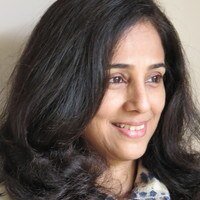
Swati Chemburkar
Course Director at Benaras Hindu University, Mumbai, Swati Chemburkar studies the interconnection between Khmer arts and Indian civilization.
An architect and historian, she teaches Southeast Asia art history at the Jnanapravaha Institute in Mumbai. Swati Chemburkar has done several field researches in Cambodia, in particular at Banteay Chhmar. She was the guest editor of Marg Magazine special edition Art of Cambodia: Interactions with India for India Art Fair 2015 (Marg, Vol. 67, no. 2, December 2015-March 2016).
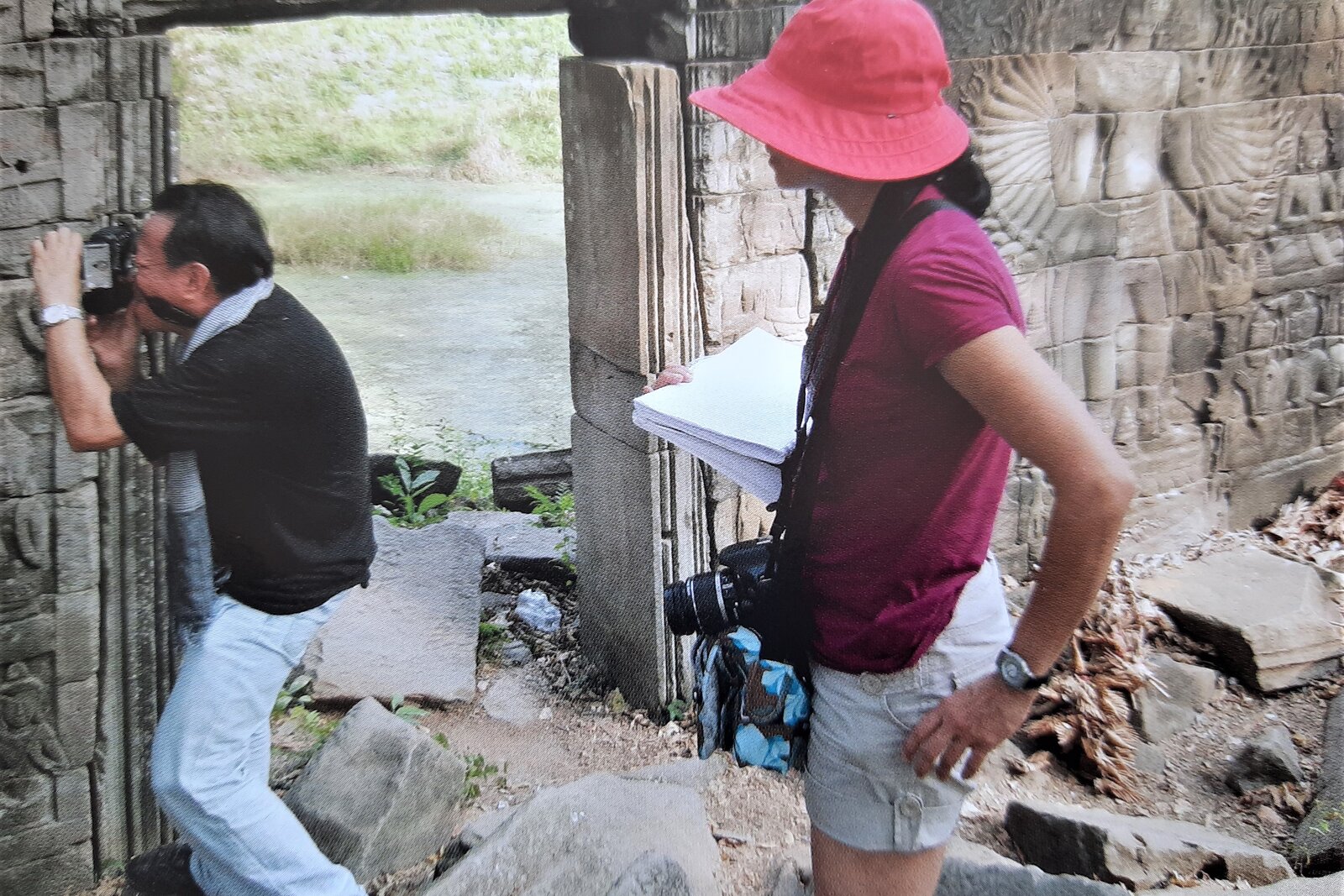
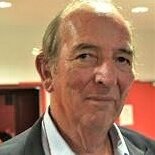
John Sanday
British architect and conservationist John Sanday has been associated to many Global Heritage Fund projects, especially in Nepal and Cambodia.
He became Asia Field Director for the GHF in 2007.
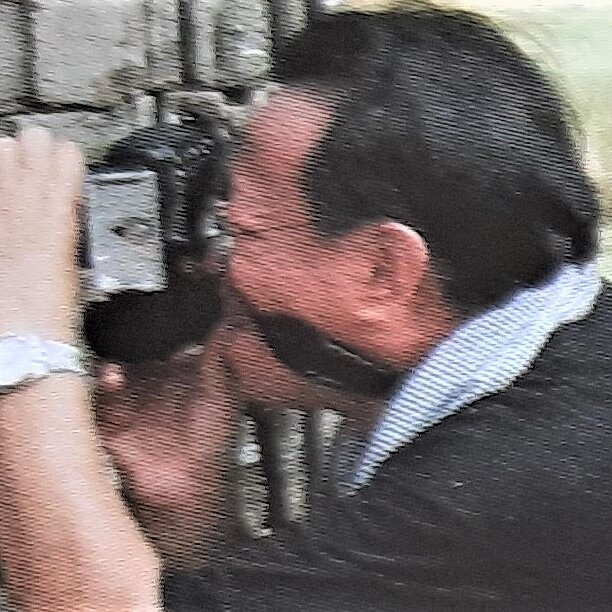
Paisarn Piemmettawat
Photographer Paisarn Piemmettawat has contributed to numerous books on Southeast Asian art and history, including Cambodia. He is currently Managing Director of River Books Publishing, Bangkok, Thailand.

